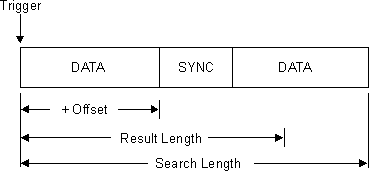Constellation Sync Search (Digital Demod)
uses a synchronization pattern to isolate a segment of the signal for display and analysis. The demodulator searches through demodulated data to find the sync pattern and then uses the Result Length to determine how much data to display and uses Search Offset to display data relative to the sync pattern.
Synchronization words (or patterns) are often used to resolve carrier phase ambiguity on non-differential modulation formats. It is important to realize that synchronization words are optional and are not necessary in order to achieve carrier locking.
The sync pattern must be a multiple of the number of bits-per-symbol. For example, if the number of bits-per-symbol is 4 (as with 16 QAM Quadrature Amplitude Modulation), the number of bits in the sync pattern must be a multiple of four. Sync search specifies any number of bits for the sync pattern, however, bits that are not a multiple of the bits-per-symbol are truncated. In this example, if 6 bits is entered for the sync pattern, sync search would only use the first four bits.
With off, triggering determines when the demodulator starts demodulating data and determines when the demodulator stops demodulating data. Sync Search locates only the first match and ignores any subsequent matches within the . The sync pattern and the must fit within the search length.
Use with or without , although many measurements require both features.
uses the following parameters:
- Result Length determines how much data is displayed.
- Search Length determines how much data the VSA searches through to find the sync pattern.
- Search Offset and the sync pattern determine the location of within .
- Search Pattern specifies the sync pattern.
Using Constellation Sync Search
There are two ways to use sync search:
- with Pulse Search OFF
- with ON
The following paragraphs describe with OFF. To learn how works with ON, see Pulse Search.
Constellation Sync Search with Pulse Search OFF
The following illustration shows how sync search works when is OFF. The illustration shows a positive (+) offset.

Trigger determines the start of search length.
Offset determines the position of result length with respect to the start of the sync pattern.
Result Length determines how much data is displayed.
Search Length determines how much data is demodulated.
Triggering
Selecting an appropriate trigger is critical when using . Basically, the VSA must be triggered such that the sync pattern and fit within .
If the is set less than the , the VSA sets the equal to the .
The trigger signal determines when the VSA begins accumulating data for . The VSA begins to demodulate the signal when it receives a valid trigger and continues to demodulate the signal for the duration of . If does not contain the sync pattern, the VSA shows the trace indicator.
The location of the sync pattern and the value of Search Offset determine the location of within . Because the sync pattern can occur anywhere within , it is possible to specify a such that the doesn't fit within the . If this situation occurs, the VSA shows the trace indicator.
If the demodulator finds two or more sync patterns in the , the VSA ignores all but the first sync pattern.
External trigger can be selected and a signal connected to the VSA's EXT TRIGGER BNC. In this case, a valid external-trigger signal causes the VSA to capture the amount of data specified by .
If Free Run trigger is used for continuous transmissions, care must be taken when setting the . For best results, set large enough to include at least two .
For additional information for troubleshooting digital demodulated measurements, see Troubleshooting.
